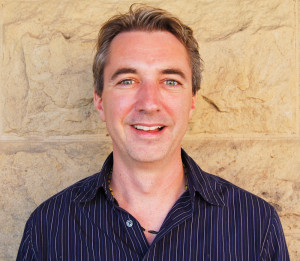Tom Kealey is a lecturer in Stanford’s Creative Writing Program and the author of “Thieves I’ve Known,” a collection of short stories that has won critical acclaim and which will be published later this year. The Daily sat down to talk with Kealey about “coding” stories, his first day of teaching and his new book.

The Stanford Daily (TSD): Where did you attend college? When did you realize that you wanted to be a working writer?
Tom Kealey (TK): I majored in history and English at University of North Carolina Greensboro, or UNCG. I took writing classes there and liked it a lot. A group of my friends and I started a magazine during our time there [called] “Cities and Roads.” This was big — we were in our early 20s, and we were starting to make a fiction magazine before the Internet was even around.
It was really interesting to get it published and see what people liked to read. I think that was the turning point where I realized I might want to go into writing. I was reading both good and bad fiction and, in the bad fiction, recognized a lot of things that I knew I was not doing well. So that was meeting a lot of writers, a lot of readers, and we had six issues over our four years there.
Then I went to graduate school at the University of Massachusetts for creative writing and maintained a good interest in writing then. I basically was writing stories on a daily basis, and I started to get published and teaching creative writing from that point.
TSD: So tell me more about “Cities and Roads.” Did you have to support it out of your wallet, or did someone else sponsor it?
TK: We were a group of three, and I guess eventually I became the leader. We funded ourselves, paying out of our own pockets, and that’s significant since we were working as bartenders or waiters. But it was important for us — it was the craft of storytelling, helping people get their stories out in the world, figuring out a way to move our own stories in the world.
TSD: I read somewhere that you force yourself to write every day. Where do you get all your inspiration?
TK: There are some days when I’m completely inspired and others where I’m completely uninspired, but I still sit down and write. And when I look back at the writings that I did those days, I can’t see the difference. When I write, I’m trying to capture character voice or worldview, seeing the world the way the character sees the world. It’s like a new adventure, seeing the world with the character’s eyes.
TSD: When did you first begin writing?
TK: [As a kid] I read a lot in the back of my room — instead of playing outside — was always with my head in a book. But in elementary school, we had a soccer coach — Coach Osbourne — who also taught English and had us write short stories. He was reading the winning entry for one of these interschool fiction prizes, and we were laughing because we didn’t think it was very good. We thought we could have done that. And he just said, “Well, you didn’t.” And he really encouraged us to write, and I remember finding it harder than I thought it would be.
TSD: What is your writing process like?
TK: I like to think of writing as coding. We have 26 letters and punctuations to use too — we’re coding our own stories. Writing’s like figuring out a puzzle. I know the emotion I want to get across, but how can I evoke that same feeling in the reader?
TSD: Did you follow any career path before you decided you wanted to write professionally?
TK: Like a lot of people graduating from college, I didn’t know exactly what I wanted to do. I knew I wanted to do something artistic, I knew I wanted to continue writing in some way, whether for business or management training or for creative leadership, and for a while I thought I would be a trainer or teaching creativity. But I felt the pull of creative writing.
“Cities and Roads,” that’s when [creative writing] caught me. And it fused when I walked into class as a teacher. The first day I taught, I knew I wasn’t good at it, but I knew I liked it. I wanted to get good at it, and I liked the conversations I had with my students. I remember walking out of that class very clearly, thinking, “That wasn’t clearly organized, but I’m going to do better next time.”
TSD: When did you start teaching?
TK: I started teaching while I was a graduate student at the University of Massachusetts. I taught a PWR [Program in Writing and Rhetoric]-like class. Right after that, I applied for the Stegner Fellowship. I was chosen in 2001, and, for two years, we met in workshops and got to write fiction and poetry with writers from around the country and around the world, and we basically would write as much as we possibly can. After that, I became a Jones Lecturer, and they just keep hiring me.
TSD: Where did the idea for your Imaginative Realms class that you’re co-teaching with Keith Ekiss [another Jones Lecturer] come from?
TK: There was actually a survey of creative writing students asking about what sort of classes they were interested in seeing offered, and one of those was for science-fiction, fantasy, ghost stories, robots, myths, dystopias or utopias. I don’t have a big background in this, but I’ve been reading through “Game of Thrones,” and I tell myself it’s research for this class, but I was done with that series in four or five months.
TSD: Tell me more about your collection, “Thieves I’ve Known”. When did you first write these stories?
TK: I wrote many of these stories as a Stegner Fellow. Many of them are about teenagers either from North Carolina or the Pacific Northwest. [The] Pacific Northwest because when I was touring Puget Sound taking a ferry up to Alaska, much of the landscape and many of the people I met there were very similar to what I grew up with in North Carolina. Anyway, these teenagers are at the edges of society — they’re forgotten children, often poor or missing one or both parents — and the stories are about their struggle to survive and make their way in the world. The book will actually be my first [work of] fiction published — my first book was about creative writing programs.
TSD: Is there a particular time or environment or setting for these stories?
TK: For these stories, I walk the line between realism and myth, and I don’t incorporate a lot of things like cellphones or Twitter so the audience wouldn’t peg it and say that this is 2013. If anything, the audience would see this more in the 1990s. The stories are still accurate to kids today, and while the computer and Facebook [are] important and impact characters, I work on writing about relationships with people.
TSD: What was it like to win the Flannery O’Connor Award?
TK: It was nice. I was staying with a friend. I yelled, and she thought that I had hurt myself. It was a great honor. My story collection had previously come up as runner-up or finalist for a lot of difference prizes. I came so close and didn’t win in. But I reworked a few of the stories, and I don’t know if that made a difference at all, but I feel like it did. And it’s been really nice to get that recognition. We’re working on the cover, and the people at University of Georgia — where the prize is offered — are pleasant people to work with.
[The award] was like a confidence builder. I don’t feel like what I’m typing is any better, but it gives me confidence. I don’t feel any difference. It’s hard to say what opinion of me there is out there in literary circles, but there are lots of people coming in to talk to me.
TSD: Since you’re finished with your collection of short stories, are you taking a break or are you embarking on something new?
TK: I’m working on a novel that incorporates magical realism. It’s about a winged girl that lives in our world. Her wings are not beautiful, so a lot of the story is about being a freak and being comfortable with herself. I don’t know what it’s like to be a 16-year-old girl or what it’s like to have wings, but I do know what it feels like to be awkward and to not fit in.
This interview has been condensed and edited.
